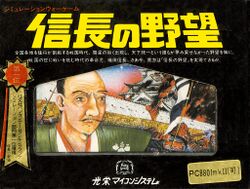This is the first game in the Nobunaga's Ambition series. For other games in the series see the Nobunaga's Ambition category.

| Nobunaga no Yabou | |
|---|---|
| Developer(s) | Koei |
| Publisher(s) | Koei |
| Year released | 1983 |
| System(s) | NEC PC-6001, NEC PC-8001, NEC PC-8801, NEC PC-9801, MSX, MSX2, Sharp MZ, Sharp X1, Fujitsu FM-7 |
| Followed by | Nobunaga no Yabou: Zankokuban |
| Series | Nobunaga's Ambition |
| Japanese title | 信長の野望 |
|---|---|
| Genre(s) | Strategy |
| Players | 1-2 |
| Modes | Single player, Multiplayer |
Nobunaga's Ambition (信長の野望 Nobunaga no Yabō?) is the first title in the Nobunaga's Ambition series, released March 1983. Written entirely in BASIC, it was compatible with a wide range of Japanese PCs. It has no subtitle. It focuses the Sengoku period (戦国時代 Sengoku jidai?) or Warring States period in Japanese history, which was a time of social upheaval, political intrigue, and nearly constant military conflict that lasted roughly from the middle of the 15th century to the beginning of the 17th century. Recreating battles that take place in Japan between 1560 and 1582, it established the historical simulation as a genre in Japan.
A remake of this game titled Nobunaga's Ambition Returns (信長の野望 リターンズ Nobunaga no Yabō Returns?) was released in 1995 for Microsoft Windows 3.1, Sega Saturn, and PlayStation. An update of this for Windows 95 was released in 1996.
-
Sharp MZ-1500 screen
Summary[edit]
The player takes the role of Oda Nobunaga (or Takeda Shingen in a two player game), a Daimyo or feudal lord of Japan. In addition to taking care of citizens of your home country, you must lead military force into battle against other Daimyos in an attempt to overthrow them and unite all of Japan under one rule. The model of Japan presented in the game contains 17 countries or fiefs. It is just as important to manage the economy of the nation as it is to manage your armies.
Gameplay consists of switching between two screens; the territory management screen which presents the national map, and the battle screen which presents a zoomed in view of one particular region. The battle portion of the game borrows from board games such as Shogi (Japanese chess) and the game of Go, and requires players to consider the strategy of the positions they take on the board.
The player develops the economy of the territories they command by governing various policies like reclamation and city planning, etc., and reinforces the army by securing war funds and food. The depth of control and management present in the game made it very popular and the game was ported to various personal and business computer systems popular throughout Japan.
This concept of management within historical simulations would be incorporated into many titles, including the Sangokushi series, and Koei established a foothold in the commercial software sector as a leader in the development in this particular type of program.
Program details[edit]
- A majority of the modules for this game were written in BASIC. As a result, many programmers could easily inspect and rewrite many portions of the program for other systems. Some bugs are present in early versions of the game
- In a two player game, one person takes control of Oda Nobunaga while the other person becomes Takeda Shingen. Each players' stats (IQ, Health, Ambition, Charisma, and Fortune) are determined randomly and set to values between 30 and 110.
- There are five difficulty settings in the game. At the fifth and hardest level, the player may be attacked by neighboring countries before he or she takes their first move, immediately after the beginning of the game. The game ends very early very frequently in this case.
- The original game is almost composed entirely of line drawings. Added details like characters and the depiction of the Daimyo's face were not present in this game, as they would be in future releases. Sound is also very simple, consisting of beeps with no BGM at all.
Game flow[edit]
At the start of the game, Japan is presented as it was in the spring of 1560, broken into 17 different territories, each with their own ruler. Territory management is conducted with one turn for every four seasons. Commands are issued to soldiers for every thing including movement, rice transportation, territory reclamation, dealing with merchants, and training. Rice and arms are bought and sold in dealings with merchants. In the disk version, loans and hiring ninjas are also possible.
On the battle screen, players fight by operating five forces (provided you have enough men in your army, or the forces will be less than five.) Four kinds of commands are available, including movement, attack, surrender, and pass. Movement moves an entire force and can only be done once per turn. The conditions for a victory during a fight is as follows:
- The entire enemy's force is annihilated first.
- The enemy's general retreats.
- The enemy runs out of food.
- The defending army endures for 30 days.
If you attack an army when their food is already depleted, you will automatically win. If a Daimyo loses two or more countries in battle, all of his countries will become part of your territory. Daimyo's with a lot of equipment are indicated by a yellow circle, while those who possess great power are indicated by an asterisk. During battle, armies can maintain a higher advantage by occupying, in order, fortresses, mountain pass, village, and plains.
Table of Contents
Nobunaga no Yabou/Table of Contents
